Variations in Arbuscular Mycorrhizal Fungi Communities During Wetland and Forest Succession in Northeast China
Abstract
:1. Introduction
2. Materials and Methods
2.1. Study Sites
2.2. Soil Sampling
2.3. Measurement of Soil Physical and Chemical Properties
2.4. DNA Extraction and PCR Amplification
2.5. Statistical Analysis
3. Results
3.1. Soil Physical and Chemical Properties
3.2. AMF Response to Ecosystem Successional Processes
3.3. Factors Affecting Ecosystem Succession
3.4. Prediction of AMF Community Function
4. Discussion
4.1. Changes in AMF During Ecosystem Succession
4.2. Drivers of Ecosystem Succession
4.3. Prediction and Analysis of AMF Community Function
5. Conclusions
Supplementary Materials
Author Contributions
Funding
Data Availability Statement
Conflicts of Interest
References
- Teixeira, H.M.; Cardoso, I.M.; Bianchi, F.J.J.A.; Silva, A.d.C.; Jamme, D.; Peña-Claros, M. Linking vegetation and soil functions during secondary forest succession in the Atlantic forest. For. Ecol. Manag. 2020, 457, 117696. [Google Scholar] [CrossRef]
- Hilmers, T.; Friess, N.; Bässler, C.; Heurich, M.; Brandl, R.; Pretzsch, H.; Seidl, R.; Müller, J.C. Biodiversity along temperate forest succession. J. Appl. Ecol. 2018, 55, 2756–2766. [Google Scholar] [CrossRef]
- Sunstein, C.R.; Vermeule, A. The Unitary Executive: Past, Present, Future. Supreme Court Rev. 2020, 2020, 83–117. [Google Scholar] [CrossRef]
- Hanusch, M.; He, X.; Ruiz-Hernández, V.; Junker, R.R. Succession comprises a sequence of threshold-induced community assembly processes towards multidiversity. Commun. Biol. 2022, 5, 424. [Google Scholar] [CrossRef]
- Poorter, L.; Amissah, L.; Bongers, F.; Hordijk, I.; Kok, J.; Laurance, S.G.W.; Lohbeck, M.; Martínez-Ramos, M.; Matsuo, T.; Meave, J.A.; et al. Successional theories. Biol. Rev. 2023, 98, 2049–2077. [Google Scholar] [CrossRef]
- Svensson, J.R.; Lindegarth, M.; Jonsson, P.R.; Pavia, H. Disturbance-diversity models: What do they really predict and how are they tested? Proc. Biol. Sci. 2012, 279, 2163–2170. [Google Scholar] [CrossRef]
- Chang, C.C.; Turner, B.L. Ecological succession in a changing world. J. Ecol. 2019, 107, 503–509. [Google Scholar] [CrossRef]
- Poorter, L.; van der Sande, M.T.; Amissah, L.; Bongers, F.; Hordijk, I.; Kok, J.; Laurance, S.G.W.; Martínez-Ramos, M.; Matsuo, T.; Meave, J.A.; et al. A comprehensive framework for vegetation succession. Ecosphere 2024, 15, e4792. [Google Scholar] [CrossRef]
- Mitsch, W.J.; Bernal, B.; Nahlik, A.M.; Mander, Ü.; Zhang, L.; Anderson, C.J.; Jørgensen, S.E.; Brix, H. Wetlands, carbon, and climate change. Landsc. Ecol. 2013, 28, 583–597. [Google Scholar] [CrossRef]
- Rogers, K.; Kelleway, J.J.; Saintilan, N.; Megonigal, J.P.; Adams, J.B.; Holmquist, J.R.; Lu, M.; Schile-Beers, L.; Zawadzki, A.; Mazumder, D.; et al. Wetland carbon storage controlled by millennial-scale variation in relative sea-level rise. Nature 2019, 567, 91–95. [Google Scholar] [CrossRef]
- Xiong, Y.; Mo, S.; Wu, H.; Qu, X.; Liu, Y.; Zhou, L. Influence of human activities and climate change on wetland landscape pattern—A review. Sci. Total Environ. 2023, 879, 163112. [Google Scholar] [CrossRef] [PubMed]
- Hansen, A.J.; Burns, P.; Ervin, J.; Goetz, S.; Hansen, M.C.; Venter, O.; Watson, J.E.M.; Jantz, P.A.; Virnig, A.L.S.; Barnett, K.; et al. A policy-driven framework for conserving the best of Earth’s remaining moist tropical forests. Nat. Ecol. Evol. 2020, 4, 1377–1384. [Google Scholar] [CrossRef] [PubMed]
- Yan, F.; Zhang, S.; Liu, X.; Yu, L.; Chen, D.; Yang, J.; Yang, C.; Bu, K.; Chang, L. Monitoring spatiotemporal changes of marshes in the Sanjiang Plain, China. Ecol. Eng. 2017, 104, 184–194. [Google Scholar] [CrossRef]
- Zhang, Z.; Xing, W.; Wang, G.; Tong, S.; Lv, X.; Sun, J. The peatlands developing history in the Sanjiang Plain, NE China and its response to East Asian monsoon variation. Sci. Rep. 2015, 5, 11316. [Google Scholar] [CrossRef]
- Wang, W.; Yang, T.; Guan, W.; Peng, W.; Wu, P.; Zhong, B.; Zhou, C.; Chen, Q.; Zhang, R.; Xu, K.; et al. Ecological wetland paradigm drives water source improvement in the stream network of Yangtze River Delta. J. Environ. Sci. 2021, 110, 55–72. [Google Scholar] [CrossRef]
- Webb, E.L.; Friess, D.A.; Krauss, K.W.; Cahoon, D.R.; Guntenspergen, G.R.; Phelps, J. A global standard for monitoring coastal wetland vulnerability to accelerated sea-level rise. Nat. Clim. Change 2013, 3, 458–465. [Google Scholar] [CrossRef]
- Mitsch, W.; Zhang, L.; Stefanik, K.; Nahlik, A.; Anderson, C.; Bernal, B.; Hernandez, M.E.; Song, K. Creating Wetlands: Primary Succession, Water Quality Changes, and Self-Design over 15 Years. BioScience 2012, 62, 237–250. [Google Scholar] [CrossRef]
- Bastida, F.; Eldridge, D.J.; García, C.; Kenny Png, G.; Bardgett, R.D.; Delgado-Baquerizo, M. Soil microbial diversity–biomass relationships are driven by soil carbon content across global biomes. ISME J. 2021, 15, 2081–2091. [Google Scholar] [CrossRef]
- Kang, Y.; Shen, L.; Li, C.; Huang, Y.; Chen, L. Effects of vegetation degradation on soil microbial communities and ecosystem multifunctionality in a karst region, southwest China. J. Environ. Manag. 2024, 363, 121395. [Google Scholar] [CrossRef]
- Jiang, S.; Ling, N.; Ma, Z.; He, X.; He, J.-S. Short-term warming increases root-associated fungal community dissimilarities among host plant species on the Qinghai-Tibetan Plateau. Plant Soil 2021, 466, 597–611. [Google Scholar] [CrossRef]
- Guo, X.; Feng, J.; Shi, Z.; Zhou, X.; Yuan, M.; Tao, X.; Hale, L.; Yuan, T.; Wang, J.; Qin, Y.; et al. Climate warming leads to divergent succession of grassland microbial communities. Nat. Clim. Change 2018, 8, 813–818. [Google Scholar] [CrossRef]
- Xu, J.; Liu, S.; Song, S.; Guo, H.; Tang, J.; Yong, J.W.H.; Ma, Y.; Chen, X. Arbuscular mycorrhizal fungi influence decomposition and the associated soil microbial community under different soil phosphorus availability. Soil Biol. Biochem. 2018, 120, 181–190. [Google Scholar] [CrossRef]
- Zhang, L.; Zhou, J.; George, T.S.; Limpens, E.; Feng, G. Arbuscular mycorrhizal fungi conducting the hyphosphere bacterial orchestra. Trends Plant Sci. 2022, 27, 402–411. [Google Scholar] [CrossRef] [PubMed]
- Akter, S.; Kamruzzaman, M.; Sarder, M.P.; Amin, M.S.; Joardar, J.C.; Islam, M.S.; Nasrin, S.; Islam, M.U.; Islam, F.; Rabbi, S.; et al. Mycorrhizal fungi increase plant nutrient uptake, aggregate stability and microbial biomass in the clay soil. Symbiosis 2024, 93, 163–176. [Google Scholar] [CrossRef]
- Lutz, S.; Bodenhausen, N.; Hess, J.; Valzano-Held, A.; Waelchli, J.; Deslandes-Hérold, G.; Schlaeppi, K.; van der Heijden, M.G.A. Soil microbiome indicators can predict crop growth response to large-scale inoculation with arbuscular mycorrhizal fungi. Nat. Microbiol. 2023, 8, 2277–2289. [Google Scholar] [CrossRef]
- Gao, X.; Guo, H.; Zhang, Q.; Guo, H.; Zhang, L.; Zhang, C.; Gou, Z.; Liu, Y.; Wei, J.; Chen, A.; et al. Arbuscular mycorrhizal fungi (AMF) enhanced the growth, yield, fiber quality and phosphorus regulation in upland cotton (Gossypium hirsutum L.). Sci. Rep. 2020, 10, 2084. [Google Scholar] [CrossRef]
- Li, S.; Chi, S.; Lin, C.; Cai, C.; Yang, L.; Peng, K.; Huang, X.; Liu, J. Combination of biochar and AMF promotes phosphorus utilization by stimulating rhizosphere microbial co-occurrence networks and lipid metabolites of Phragmites. Sci. Total Environ. 2022, 845, 157339. [Google Scholar] [CrossRef]
- Liu, B.; Li, Y.; Zhang, X.; Wang, J.; Gao, M. Effects of chlortetracycline on soil microbial communities: Comparisons of enzyme activities to the functional diversity via Biolog EcoPlates™. Eur. J. Soil Biol. 2015, 68, 69–76. [Google Scholar] [CrossRef]
- Chen, S.; Liang, Z.; Webster, R.; Zhang, G.; Zhou, Y.; Teng, H.; Hu, B.; Arrouays, D.; Shi, Z. A high-resolution map of soil pH in China made by hybrid modelling of sparse soil data and environmental covariates and its implications for pollution. Sci. Total Environ. 2019, 655, 273–283. [Google Scholar] [CrossRef]
- Lin, L.; Gao, Z.; Liu, X. Estimation of soil total nitrogen using the synthetic color learning machine (SCLM) method and hyperspectral data. Geoderma 2020, 380, 114664. [Google Scholar] [CrossRef]
- Cui, Y.; Wang, X.; Zhang, X.; Ju, W.; Duan, C.; Guo, X.; Wang, Y.; Fang, L. Soil moisture mediates microbial carbon and phosphorus metabolism during vegetation succession in a semiarid region. Soil Biol. Biochem. 2020, 147, 107814. [Google Scholar] [CrossRef]
- Zhang, G.; Bai, J.; Zhao, Q.; Jia, J.; Wang, X.; Wang, W.; Wang, X. Soil carbon storage and carbon sources under different Spartina alterniflora invasion periods in a salt marsh ecosystem. CATENA 2021, 196, 104831. [Google Scholar] [CrossRef]
- Baradaran Motie, J.; Aghkhani, M.H.; Rohani, A.; Lakzian, A. A soft-computing approach to estimate soil electrical conductivity. Biosyst. Eng. 2021, 205, 105–120. [Google Scholar] [CrossRef]
- Ivanov, K.; Zaprjanova, P.; Petkova, M.; Stefanova, V.; Kmetov, V.; Georgieva, D.; Angelova, V. Comparison of inductively coupled plasma mass spectrometry and colorimetric determination of total and extractable phosphorus in soils. Spectrochim. Acta Part B At. Spectrosc. 2012, 71–72, 117–122. [Google Scholar] [CrossRef]
- Tian, H.; Qiao, J.; Zhu, Y.; Jia, X.; Shao, M.a. Vertical distribution of soil available phosphorus and soil available potassium in the critical zone on the Loess Plateau, China. Sci. Rep. 2021, 11, 3159. [Google Scholar] [CrossRef]
- Shen, Y.; Cheng, R.; Xiao, W.; Zeng, L.; Wang, L.; Sun, P.; Chen, T. Temporal dynamics of soil nutrients in the riparian zone: Effects of water fluctuations after construction of the Three Gorges Dam. Ecol. Indic. 2022, 139, 108865. [Google Scholar] [CrossRef]
- Li, T.; Zhang, S.; Hu, J.; Hou, H.; Li, K.; Fan, Q.; Wang, F.; Li, L.; Cui, X.; Liu, D.; et al. Soil sample sizes for DNA extraction substantially affect the examination of microbial diversity and co-occurrence patterns but not abundance. Soil Biol. Biochem. 2023, 177, 108902. [Google Scholar] [CrossRef]
- Saidi-Mehrabad, A.; Neuberger, P.; Cavaco, M.; Froese, D.; Lanoil, B. Optimization of subsampling, decontamination, and DNA extraction of difficult peat and silt permafrost samples. Sci. Rep. 2020, 10, 14295. [Google Scholar] [CrossRef]
- Lo Coco, F.; Pisegna, S.; Diverio, D. The AML1 gene: A transcription factor involved in the pathogenesis of myeloid and lymphoid leukemias. Haematologica 1997, 82, 364–370. [Google Scholar]
- Naik, T.; Sharda, M.; Lakshminarayanan, C.; Virbhadra, K.; Pandit, A. High-quality single amplicon sequencing method for illumina MiSeq platform using pool of ‘N’ (0–10) spacer-linked target specific primers without PhiX spike-in. BMC Genom. 2023, 24, 141. [Google Scholar] [CrossRef]
- Bürgmann, H.; Pesaro, M.; Widmer, F.; Zeyer, J. A strategy for optimizing quality and quantity of DNA extracted from soil. J. Microbiol. Methods 2001, 45, 7–20. [Google Scholar] [CrossRef] [PubMed]
- Yin, C.; Casa Vargas, J.M.; Schlatter, D.C.; Hagerty, C.H.; Hulbert, S.H.; Paulitz, T.C. Rhizosphere community selection reveals bacteria associated with reduced root disease. Microbiome 2021, 9, 86. [Google Scholar] [CrossRef] [PubMed]
- Burja, A.M.; Tamagnini, P.; Bustard, M.T.; Wright, P.C. Identification of the green alga, Chlorella vulgaris (SDC1) using cyanobacteria derived 16S rDNA primers: Targeting the chloroplast. FEMS Microbiol. Lett. 2001, 202, 195–203. [Google Scholar] [CrossRef]
- Guo, Y.; Bei, Q.; Dzomeku, B.M.; Martin, K.; Rasche, F. Genetic diversity and community composition of arbuscular mycorrhizal fungi associated with root and rhizosphere soil of the pioneer plant Pueraria phaseoloides. Imeta 2022, 1, e51. [Google Scholar] [CrossRef]
- Kalita, M.J.; Dutta, K.; Hazarika, G.; Dutta, R.; Kalita, S.; Das, P.P.; Sarma, M.P.; Banu, S.; Idris, M.G.; Talukdar, A.J.; et al. In-house reverse transcriptase polymerase chain reaction for detection of SARS-CoV-2 with increased sensitivity. Sci. Rep. 2021, 11, 17878. [Google Scholar] [CrossRef]
- Kinoshita, Y.; Niwa, H.; Uchida-Fujii, E.; Nukada, T. Establishment and assessment of an amplicon sequencing method targeting the 16S-ITS-23S rRNA operon for analysis of the equine gut microbiome. Sci. Rep. 2021, 11, 11884. [Google Scholar] [CrossRef]
- Opik, M.; Vanatoa, A.; Vanatoa, E.; Moora, M.; Davison, J.; Kalwij, J.M.; Reier, U.; Zobel, M. The online database MaarjAM reveals global and ecosystemic distribution patterns in arbuscular mycorrhizal fungi (Glomeromycota). New Phytol. 2010, 188, 223–241. [Google Scholar] [CrossRef]
- Liu, X.; Yan, Z.; Wu, C.; Yang, Y.; Li, X.; Zhang, G. FastProNGS: Fast preprocessing of next-generation sequencing reads. BMC Bioinform. 2019, 20, 345. [Google Scholar] [CrossRef]
- Grant, G.R.; Farkas, M.H.; Pizarro, A.D.; Lahens, N.F.; Schug, J.; Brunk, B.P.; Stoeckert, C.J.; Hogenesch, J.B.; Pierce, E.A. Comparative analysis of RNA-Seq alignment algorithms and the RNA-Seq unified mapper (RUM). Bioinformatics 2011, 27, 2518–2528. [Google Scholar] [CrossRef]
- Li, J.; Nie, M.; Pendall, E. Soil physico-chemical properties are more important than microbial diversity and enzyme activity in controlling carbon and nitrogen stocks near Sydney, Australia. Geoderma 2020, 366, 114201. [Google Scholar] [CrossRef]
- Wang, J.; Gao, X.; Wang, J.; Song, J.; Zhu, Z.; Zhao, J.; Liu, M.; Wang, Z. Host plants directly determine the α diversity of rhizosphere arbuscular mycorrhizal fungal communities in the National Tropical Fruit Tree Field Genebank. Chem. Biol. Technol. Agric. 2024, 11, 20. [Google Scholar] [CrossRef]
- Foster, Z.S.; Sharpton, T.J.; Grünwald, N.J. Metacoder: An R package for visualization and manipulation of community taxonomic diversity data. PLoS Comput. Biol. 2017, 13, e1005404. [Google Scholar] [CrossRef] [PubMed]
- Geng, J.; Zhang, W.; Liang, S.; Xue, N.; Song, W.; Yang, Y. Diversity and biogeography of bacterial community in the Ili River network varies locally and regionally. Water Res. 2024, 256, 121561. [Google Scholar] [CrossRef] [PubMed]
- Samuel, S.O.; Suzuki, K.; Asiloglu, R.; Harada, N. Soil-root interface influences the assembly of the endophytic bacterial community in rice plants. Biol. Fertil. Soils 2022, 58, 35–48. [Google Scholar] [CrossRef]
- Wang, C.; Zhu, B.; Guo, Y.; Tian, S.; Zhang, Z.; Hou, X. Assessment of the Pollution of Soil Heavy Metal(loid)s and Its Relation with Soil Microorganisms in Wetland Soils. Sustainability 2022, 14, 12164. [Google Scholar] [CrossRef]
- Jiang, W.-J.; Wang, R.-Q.; Zhu, T.-Y.; Feng, M.; Sun, D.-X.; Yang, J.-H.; Qi, X.-D.; Wang, Y. Tree-ring structured phase change materials with high through-plane thermal conductivity and flexibility for advanced thermal management. Chem. Eng. J. 2024, 479, 147622. [Google Scholar] [CrossRef]
- Wang, L.; Yan, B.; Prasher, S.O.; Ou, Y.; Bian, Y.; Cui, H. The response of microbial composition and enzyme activities to hydrological gradients in a riparian wetland. J. Soils Sediments 2019, 19, 4031–4041. [Google Scholar] [CrossRef]
- Du, J.; Jia, T.; Liu, J.; Chai, B. Relationships among protozoa, bacteria and fungi in polycyclic aromatic hydrocarbon-contaminated soils. Ecotoxicol. Environ. Saf. 2024, 270, 115904. [Google Scholar] [CrossRef]
- Douglas, G.M.; Maffei, V.J.; Zaneveld, J.R.; Yurgel, S.N.; Brown, J.R.; Taylor, C.M.; Huttenhower, C.; Langille, M.G.I. PICRUSt2 for prediction of metagenome functions. Nat. Biotechnol. 2020, 38, 685–688. [Google Scholar] [CrossRef]
- Ye, J.-z.; Lin, X.-m.; Cheng, Z.-x.; Su, Y.-b.; Li, W.-x.; Ali, F.-m.; Zheng, J.; Peng, B. Identification and efficacy of glycine, serine and threonine metabolism in potentiating kanamycin-mediated killing of Edwardsiella piscicida. J. Proteom. 2018, 183, 34–44. [Google Scholar] [CrossRef]
- Fernandes, G.R.; Mudado, M.A.; Ortega, J.M. Testing the performance of automated annotation of ESTs with the Kegg Orthology (KO) database demonstrates lack of completeness of clusters. Genet. Mol. Res. 2008, 7, 948–957. [Google Scholar] [CrossRef] [PubMed]
- Krieger, C.J.; Zhang, P.; Mueller, L.A.; Wang, A.; Paley, S.; Arnaud, M.; Pick, J.; Rhee, S.Y.; Karp, P.D. MetaCyc: A multiorganism database of metabolic pathways and enzymes. Nucleic Acids Res. 2004, 32, D438–D442. [Google Scholar] [CrossRef] [PubMed]
- Anderson, M.J. Permutational Multivariate Analysis of Variance (PERMANOVA); Balakrishnan, N., Colton, T., Everitt, B., Piegorsch, W., Ruggeri, F., Teugels, J.L., Eds.; John Wiley & Sons, Ltd.: Hoboken, NJ, USA, 2017; pp. 1–15. [Google Scholar]
- Anderson, M.; Gorley, R.N.; Clarke, K. PERMANOVA+ for Primer: Guide to Software and Statistical Methods; PRIMER-E; Plymouth Marine Laboratory: Plymouth, UK, 2008. [Google Scholar]
- Albrecht, J.; Peters, M.K.; Becker, J.N.; Behler, C.; Classen, A.; Ensslin, A.; Ferger, S.W.; Gebert, F.; Gerschlauer, F.; Helbig-Bonitz, M.; et al. Species richness is more important for ecosystem functioning than species turnover along an elevational gradient. Nat. Ecol. Evol. 2021, 5, 1582–1593. [Google Scholar] [CrossRef] [PubMed]
- Zhao, X.; Hao, Y.; Wang, T.; Dong, L.; Li, F. Competition is critical to the growth of Larix gmelinii and Betula platyphylla in secondary forests in Northeast China under climate change. Glob. Ecol. Conserv. 2024, 51, e02935. [Google Scholar] [CrossRef]
- Hong, S.; Piao, S.; Chen, A.; Liu, Y.; Liu, L.; Peng, S.; Sardans, J.; Sun, Y.; Peñuelas, J.; Zeng, H. Afforestation neutralizes soil pH. Nat. Commun. 2018, 9, 520. [Google Scholar] [CrossRef]
- Beillouin, D.; Corbeels, M.; Demenois, J.; Berre, D.; Boyer, A.; Fallot, A.; Feder, F.; Cardinael, R. A global meta-analysis of soil organic carbon in the Anthropocene. Nat. Commun. 2023, 14, 3700. [Google Scholar] [CrossRef]
- Coonan, E.C.; Kirkby, C.A.; Kirkegaard, J.A.; Amidy, M.R.; Strong, C.L.; Richardson, A.E. Microorganisms and nutrient stoichiometry as mediators of soil organic matter dynamics. Nutr. Cycl. Agroecosystems 2020, 117, 273–298. [Google Scholar] [CrossRef]
- Ma, X.; Qu, H.; Liu, X.; Zhang, Y.; Chao, L.; Liu, H.; Bao, Y. Changes of root AMF community structure and colonization levels under distribution pattern of geographical substitute for four Stipa species in arid steppe. Microbiol. Res. 2023, 271, 127371. [Google Scholar] [CrossRef]
- Santoyo, G. How plants recruit their microbiome? New insights into beneficial interactions. J. Adv. Res. 2022, 40, 45–58. [Google Scholar] [CrossRef]
- Yu, H.; Liu, X.; Yang, C.; Peng, Y.; Yu, X.; Gu, H.; Zheng, X.; Wang, C.; Xiao, F.; Shu, L.; et al. Co-symbiosis of arbuscular mycorrhizal fungi (AMF) and diazotrophs promote biological nitrogen fixation in mangrove ecosystems. Soil Biol. Biochem. 2021, 161, 108382. [Google Scholar] [CrossRef]
- Anthony, M.A.; Crowther, T.W.; van der Linde, S.; Suz, L.M.; Bidartondo, M.I.; Cox, F.; Schaub, M.; Rautio, P.; Ferretti, M.; Vesterdal, L.; et al. Forest tree growth is linked to mycorrhizal fungal composition and function across Europe. ISME J. 2022, 16, 1327–1336. [Google Scholar] [CrossRef] [PubMed]
- Fisher, R.M.; Henry, L.M.; Cornwallis, C.K.; Kiers, E.T.; West, S.A. The evolution of host-symbiont dependence. Nat. Commun. 2017, 8, 15973. [Google Scholar] [CrossRef] [PubMed]
- Duan, S.; Feng, G.; Limpens, E.; Bonfante, P.; Xie, X.; Zhang, L. Cross-kingdom nutrient exchange in the plant-arbuscular mycorrhizal fungus-bacterium continuum. Nat. Rev. Microbiol. 2024, 22, 773–790. [Google Scholar] [CrossRef]
- Hu, Y.N.; Zhao, L.; Buggs, R.J.A.; Zhang, X.M.; Li, J.; Wang, N. Population structure of Betula albosinensis and Betula platyphylla: Evidence for hybridization and a cryptic lineage. Ann Bot 2019, 123, 1179–1189. [Google Scholar] [CrossRef]
- Wu, Z.; Fan, C.; Zhang, C.; Zhao, X.; von Gadow, K. Effects of biotic and abiotic drivers on the growth rates of individual trees in temperate natural forests. For. Ecol. Manag. 2022, 503, 119769. [Google Scholar] [CrossRef]
- Solomon, W.; Janda, T.; Molnár, Z. Unveiling the significance of rhizosphere: Implications for plant growth, stress response, and sustainable agriculture. Plant Physiol. Biochem. 2024, 206, 108290. [Google Scholar] [CrossRef]
- Marathe, A.; Priyadarsanan, D.R.; Krishnaswamy, J.; Shanker, K. Gamma diversity and under-sampling together generate patterns in beta-diversity. Sci. Rep. 2021, 11, 21420. [Google Scholar] [CrossRef]
- Tian, B.; Pei, Y.; Huang, W.; Ding, J.; Siemann, E. Increasing flavonoid concentrations in root exudates enhance associations between arbuscular mycorrhizal fungi and an invasive plant. ISME J. 2021, 15, 1919–1930. [Google Scholar] [CrossRef]
- Vives-Peris, V.; de Ollas, C.; Gómez-Cadenas, A.; Pérez-Clemente, R.M. Root exudates: From plant to rhizosphere and beyond. Plant Cell Rep. 2020, 39, 3–17. [Google Scholar] [CrossRef]
- Liu, T.; Wu, X.; Li, H.; Alharbi, H.; Wang, J.; Dang, P.; Chen, X.; Kuzyakov, Y.; Yan, W. Soil organic matter, nitrogen and pH driven change in bacterial community following forest conversion. For. Ecol. Manag. 2020, 477, 118473. [Google Scholar] [CrossRef]
- Liu, R.; Li, M.; Guo, S.; Chen, Y. The Role of AMF Community Composition, Diversity, and Distribution in Sustainable Agroecosystems. In Arbuscular Mycorrhizal Fungi in Sustainable Agriculture: Inoculum Production and Application; Springer Nature: Singapore, 2024; pp. 281–317. [Google Scholar]
- Ferlian, O.; Goldmann, K.; Eisenhauer, N.; Tarkka, M.T.; Buscot, F.; Heintz-Buschart, A. Distinct effects of host and neighbour tree identity on arbuscular and ectomycorrhizal fungi along a tree diversity gradient. ISME Commun. 2021, 1, 40. [Google Scholar] [CrossRef] [PubMed]
- Petri, L.; Ibáñez, I. Assessing the mechanisms and impacts of shrub invasion in forests: A meta-analysis. J. Appl. Ecol. 2023, 60, 2314–2326. [Google Scholar] [CrossRef]
- Pierce, N.; Archer, S.; Bestelmeyer, B. Competition suppresses shrubs during early, but not late, stages of arid grassland–shrubland state transition. Funct. Ecol. 2019, 33, 1480–1490. [Google Scholar] [CrossRef]
- Zhang, J.; Diao, F.; Hao, B.; Xu, L.; Jia, B.; Hou, Y.; Ding, S.; Guo, W. Multiomics reveals Claroideoglomus etunicatum regulates plant hormone signal transduction, photosynthesis and La compartmentalization in maize to promote growth under La stress. Ecotoxicol. Environ. Saf. 2023, 262, 115128. [Google Scholar] [CrossRef]
- Ahluwalia, O.; Singh, P.C.; Bhatia, R. A review on drought stress in plants: Implications, mitigation and the role of plant growth promoting rhizobacteria. Resour. Environ. Sustain. 2021, 5, 100032. [Google Scholar] [CrossRef]
- Jiao, S.; Yang, Y.; Xu, Y.; Zhang, J.; Lu, Y. Balance between community assembly processes mediates species coexistence in agricultural soil microbiomes across eastern China. ISME J. 2020, 14, 202–216. [Google Scholar] [CrossRef]
- Melbourne, B.A.; Hastings, A. Extinction risk depends strongly on factors contributing to stochasticity. Nature 2008, 454, 100–103. [Google Scholar] [CrossRef]
- Kaur, S.; Campbell, B.J.; Suseela, V. Root metabolome of plant-arbuscular mycorrhizal symbiosis mirrors the mutualistic or parasitic mycorrhizal phenotype. New Phytol 2022, 234, 672–687. [Google Scholar] [CrossRef]
- Bhantana, P.; Rana, M.S.; Sun, X.-C.; Moussa, M.G.; Saleem, M.H.; Syaifudin, M.; Shah, A.; Poudel, A.; Pun, A.B.; Bhat, M.A.; et al. Arbuscular mycorrhizal fungi and its major role in plant growth, zinc nutrition, phosphorous regulation and phytoremediation. Symbiosis 2021, 84, 19–37. [Google Scholar] [CrossRef]
- Dhungana, I.; Kantar, M.B.; Nguyen, N.H. Root exudate composition from different plant species influences the growth of rhizosphere bacteria. Rhizosphere 2023, 25, 100645. [Google Scholar] [CrossRef]
- Khan, F.; Siddique, A.B.; Shabala, S.; Zhou, M.; Zhao, C. Phosphorus Plays Key Roles in Regulating Plants’ Physiological Responses to Abiotic Stresses. Plants 2023, 12, 2861. [Google Scholar] [CrossRef] [PubMed]
- González Rojas, J.C.; Salazar Orellana, M.J. Arbuscular Mycorrhizal: Invisible Allies in Plant Development. In Soil Microbiome in Green Technology Sustainability; Aransiola, S.A., Atta, H.I., Maddela, N.R., Eds.; Springer Nature Switzerland: Cham, Switzerland, 2024; pp. 511–524. [Google Scholar]
- Ciancio, A. Symbiotic Relationships. In Invertebrate Bacteriology: Function, Evolution and Biological Ties; Ciancio, A., Ed.; Springer Netherlands: Dordrecht, The Netherlands, 2016; pp. 49–96. [Google Scholar]
- Wang, C.; Xue, L.; Jiao, R. Soil phosphorus fractions, phosphatase activity, and the abundance of phoC and phoD genes vary with planting density in subtropical Chinese fir plantations. Soil Tillage Res. 2021, 209, 104946. [Google Scholar] [CrossRef]
- Hortal, S.; Lozano, Y.M.; Bastida, F.; Armas, C.; Moreno, J.L.; Garcia, C.; Pugnaire, F.I. Plant-plant competition outcomes are modulated by plant effects on the soil bacterial community. Sci. Rep. 2017, 7, 17756. [Google Scholar] [CrossRef]
- Liu, Z.; Fang, J.; He, Y.; Bending, G.D.; Song, B.; Guo, Y.; Wang, X.; Fang, Z.; Adams, J.M. Distinct biogeographic patterns in Glomeromycotinian and Mucoromycotinian arbuscular mycorrhizal fungi across China: A meta-analysis. Sci. Total Environ. 2024, 912, 168907. [Google Scholar] [CrossRef]
- Xiao, D.; Tang, Y.; Zhang, W.; Hu, P.; Wang, K. Lithology and niche habitat have significant effect on arbuscular mycorrhizal fungal abundance and their interspecific interactions. Sci. Total Environ. 2024, 919, 170774. [Google Scholar] [CrossRef]
- Mitsch, W.J.; Zhang, L.; Anderson, C.; Altor, A.E.; Hernández, M.E. Creating riverine wetlands: Ecological succession, nutrient retention, and pulsing effects. Ecol. Eng. 2005, 25, 510–527. [Google Scholar] [CrossRef]
- Ye, J.Y.; Tian, W.H.; Jin, C.W. Nitrogen in plants: From nutrition to the modulation of abiotic stress adaptation. Stress Biol. 2022, 2, 4. [Google Scholar] [CrossRef]
- Xu, Z.; Yu, G.; Zhang, X.; He, N.; Wang, Q.; Wang, S.; Wang, R.; Zhao, N.; Jia, Y.; Wang, C. Soil enzyme activity and stoichiometry in forest ecosystems along the North-South Transect in eastern China (NSTEC). Soil Biol. Biochem. 2017, 104, 152–163. [Google Scholar] [CrossRef]
- Wilson, D.F.; Matschinsky, F.M. Ethanol metabolism: The good, the bad, and the ugly. Med. Hypotheses 2020, 140, 109638. [Google Scholar] [CrossRef]
- Matthews, D.E. Review of Lysine Metabolism with a Focus on Humans. J. Nutr. 2020, 150, 2548s–2555s. [Google Scholar] [CrossRef]
- Ye, J.; Zhang, Y.; Cui, H.; Liu, J.; Wu, Y.; Cheng, Y.; Xu, H.; Huang, X.; Li, S.; Zhou, A.; et al. WEGO 2.0: A web tool for analyzing and plotting GO annotations, 2018 update. Nucleic. Acids Res. 2018, 46, W71–W75. [Google Scholar] [CrossRef] [PubMed]
- Neshich, I.A.P.; Kiyota, E.; Arruda, P. Genome-wide analysis of lysine catabolism in bacteria reveals new connections with osmotic stress resistance. ISME J. 2013, 7, 2400–2410. [Google Scholar] [CrossRef] [PubMed]
- Li, Y.; Shen, X.; Yang, X.; Lian, F.; Li, Y.; Li, J.; Huang, Y.; Shen, W.; Liu, H. CHDH, a key mitochondrial enzyme, plays a diagnostic role in metabolic disorders diseases and tumor progression. Front. Genet. 2023, 14, 1240650. [Google Scholar] [CrossRef]
- Tayebati, S.K.; Marucci, G.; Santinelli, C.; Buccioni, M.; Amenta, F. Choline-Containing Phospholipids: Structure-Activity Relationships Versus Therapeutic Applications. Curr. Med. Chem. 2015, 22, 4328–4340. [Google Scholar] [CrossRef]
- Lv, Z.; Duan, A.; Zhang, J. Influence of forest age, tree size, and climate factors on biomass and carbon storage allocation in Chinese fir forests. Ecol. Indic. 2024, 163, 112096. [Google Scholar] [CrossRef]
- Qi, X.; Cherubini, P.; Treydte, K.; Li, M.-H.; Wu, Z.; He, H.S.; Du, H.; Fang, K.; Saurer, M. Growth responses to climate warming and their physiological mechanisms differ between mature and young larch trees in a boreal permafrost region. Agric. For. Meteorol. 2023, 343, 109765. [Google Scholar] [CrossRef]
- Ding, Y.; Gao, X.; Shu, D.; Siddique, K.H.M.; Song, X.; Wu, P.; Li, C.; Zhao, X. Enhancing soil health and nutrient cycling through soil amendments: Improving the synergy of bacteria and fungi. Sci. Total Environ. 2024, 923, 171332. [Google Scholar] [CrossRef]
- Tausz, M.; Grulke, N.E. Trees in a Changing Environment: Ecophysiology, Adaptation, and Future Survival; Springer International Publishing: Cham, Switzerland, 2014. [Google Scholar]
- Wahab, A.; Muhammad, M.; Munir, A.; Abdi, G.; Zaman, W.; Ayaz, A.; Khizar, C.; Reddy, S.P.P. Role of Arbuscular Mycorrhizal Fungi in Regulating Growth, Enhancing Productivity, and Potentially Influencing Ecosystems under Abiotic and Biotic Stresses. Plants 2023, 12, 3102. [Google Scholar] [CrossRef]
- Xu, F.-Q.; Meng, L.-L.; Kuča, K.; Wu, Q.-S. The mechanism of arbuscular mycorrhizal fungi-alleviated manganese toxicity in plants: A review. Plant Physiol. Biochem. 2024, 213, 108808. [Google Scholar] [CrossRef]
- Rigoulet, M.; Bouchez, C.L.; Paumard, P.; Ransac, S.; Cuvellier, S.; Duvezin-Caubet, S.; Mazat, J.P.; Devin, A. Cell energy metabolism: An update. Biochim. Biophys. Acta Bioenerg. 2020, 1861, 148276. [Google Scholar] [CrossRef]
- Smith, M.E.; Sedgwick, B.; Brindley, D.N.; Hübscer, G. The role of phosphatidate phosphohydrolase in glyceride biosynthesis. Eur. J. Biochem. 1967, 3, 70–77. [Google Scholar] [CrossRef] [PubMed]
- Eto, S.; Matsumura, R.; Shimane, Y.; Fujimi, M.; Berhanu, S.; Kasama, T.; Kuruma, Y. Phospholipid synthesis inside phospholipid membrane vesicles. Commun. Biol. 2022, 5, 1016. [Google Scholar] [CrossRef] [PubMed]
- Lu, J.; Feng, S.; Wang, S.; Zhang, B.; Ning, Z.; Wang, R.; Chen, X.; Yu, L.; Zhao, H.; Lan, D.; et al. Patterns and driving mechanism of soil organic carbon, nitrogen, and phosphorus stoichiometry across northern China’s desert-grassland transition zone. CATENA 2023, 220, 106695. [Google Scholar] [CrossRef]
- Yao, Z.; Huang, C.; Hu, H.; Wang, T.; Li, Y.; Sun, X.; Adl, S.; Zhu, B. High trophic level organisms and the complexity of soil micro-food webs at aggregate scale regulate carbon accumulation in cropland soils. Agric. Ecosyst. Environ. 2024, 360, 108768. [Google Scholar] [CrossRef]

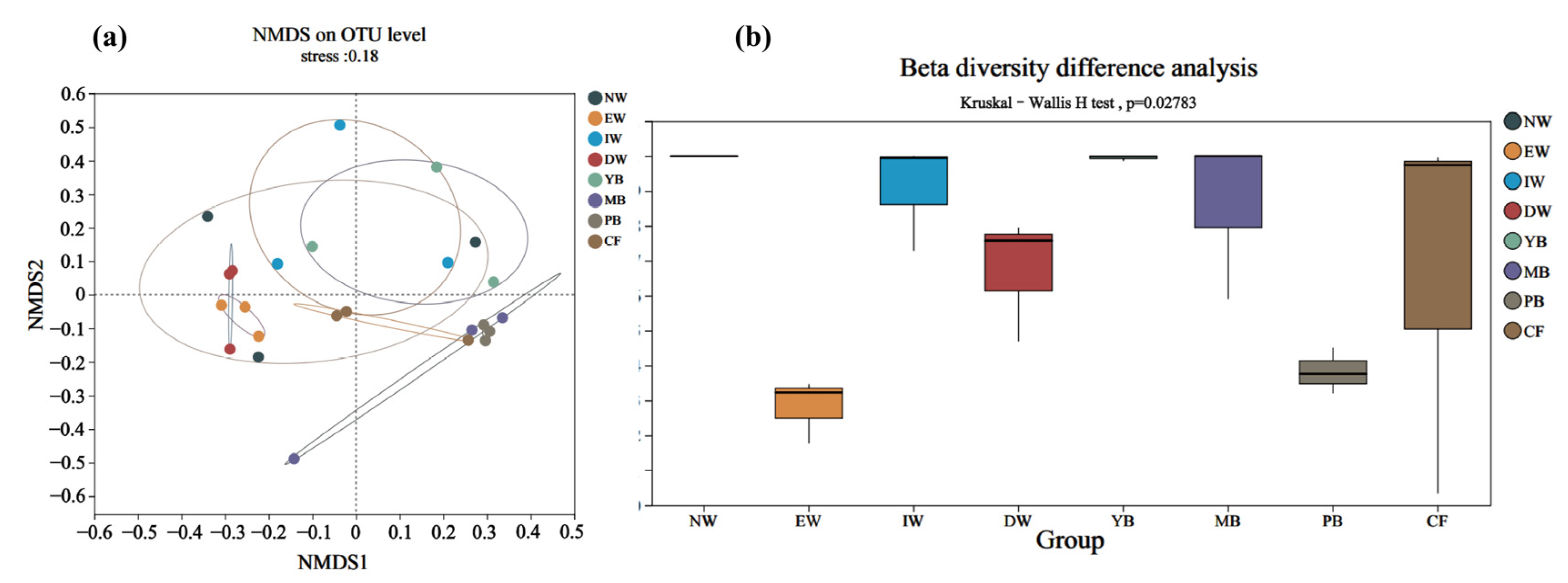


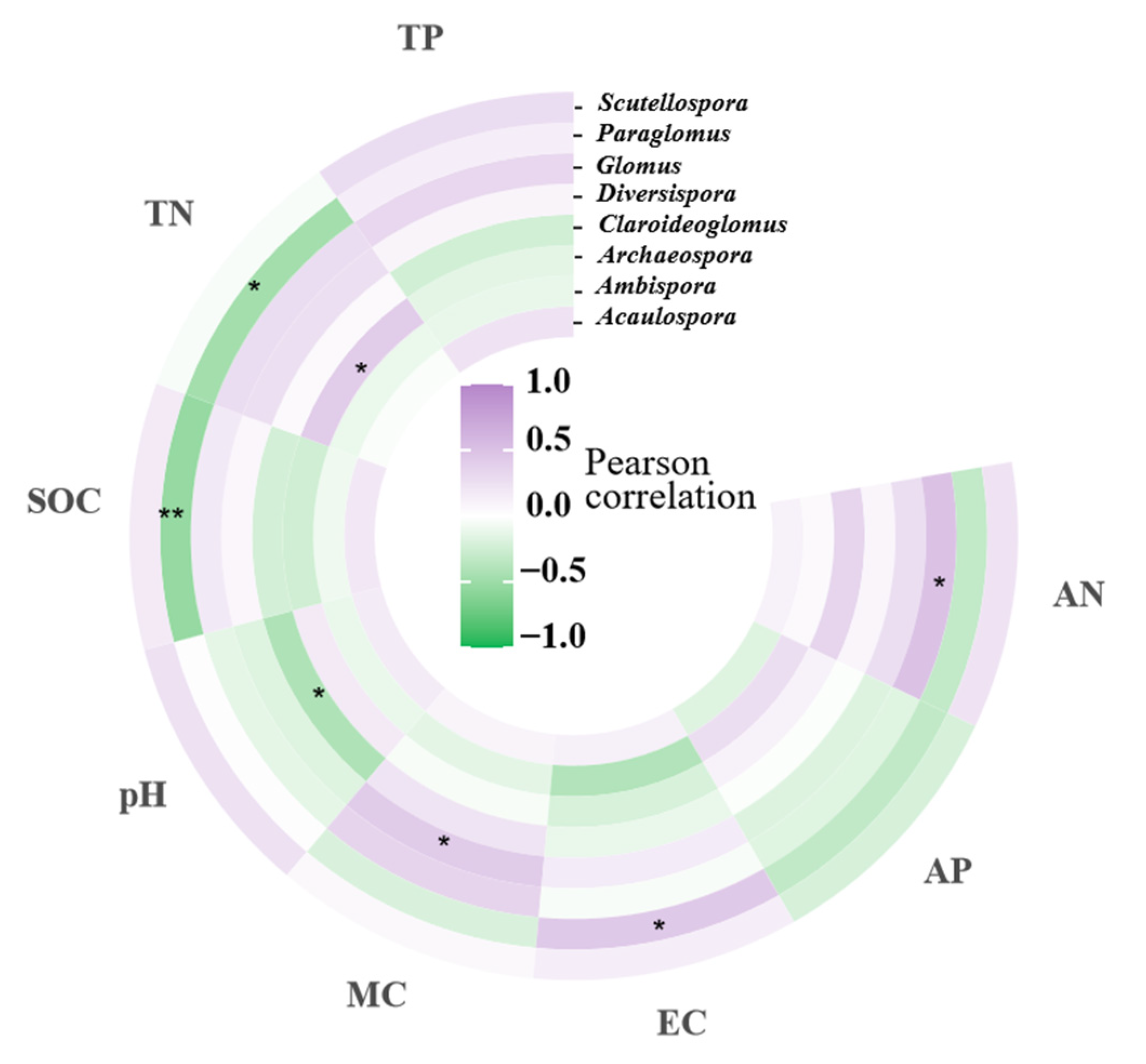
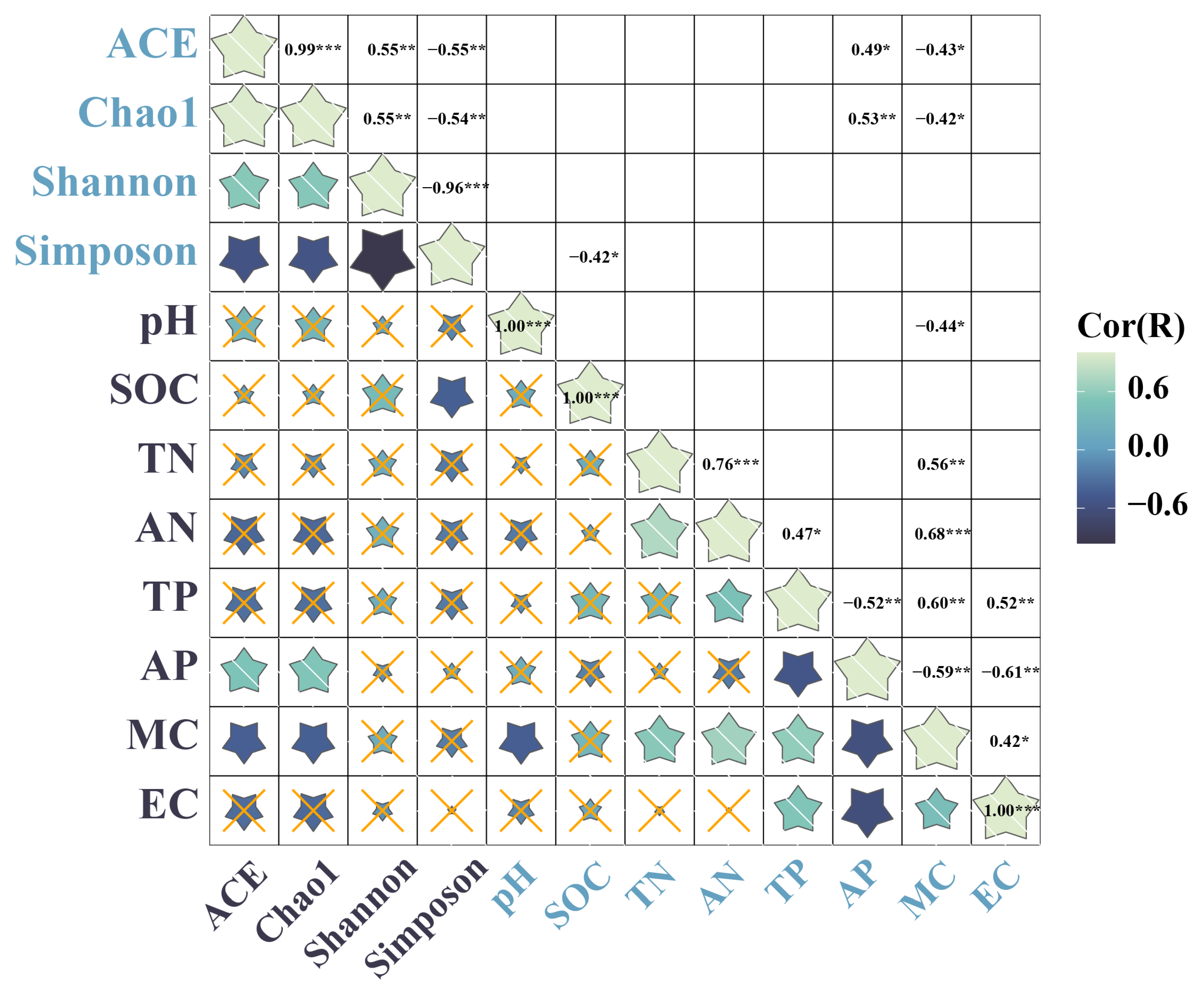
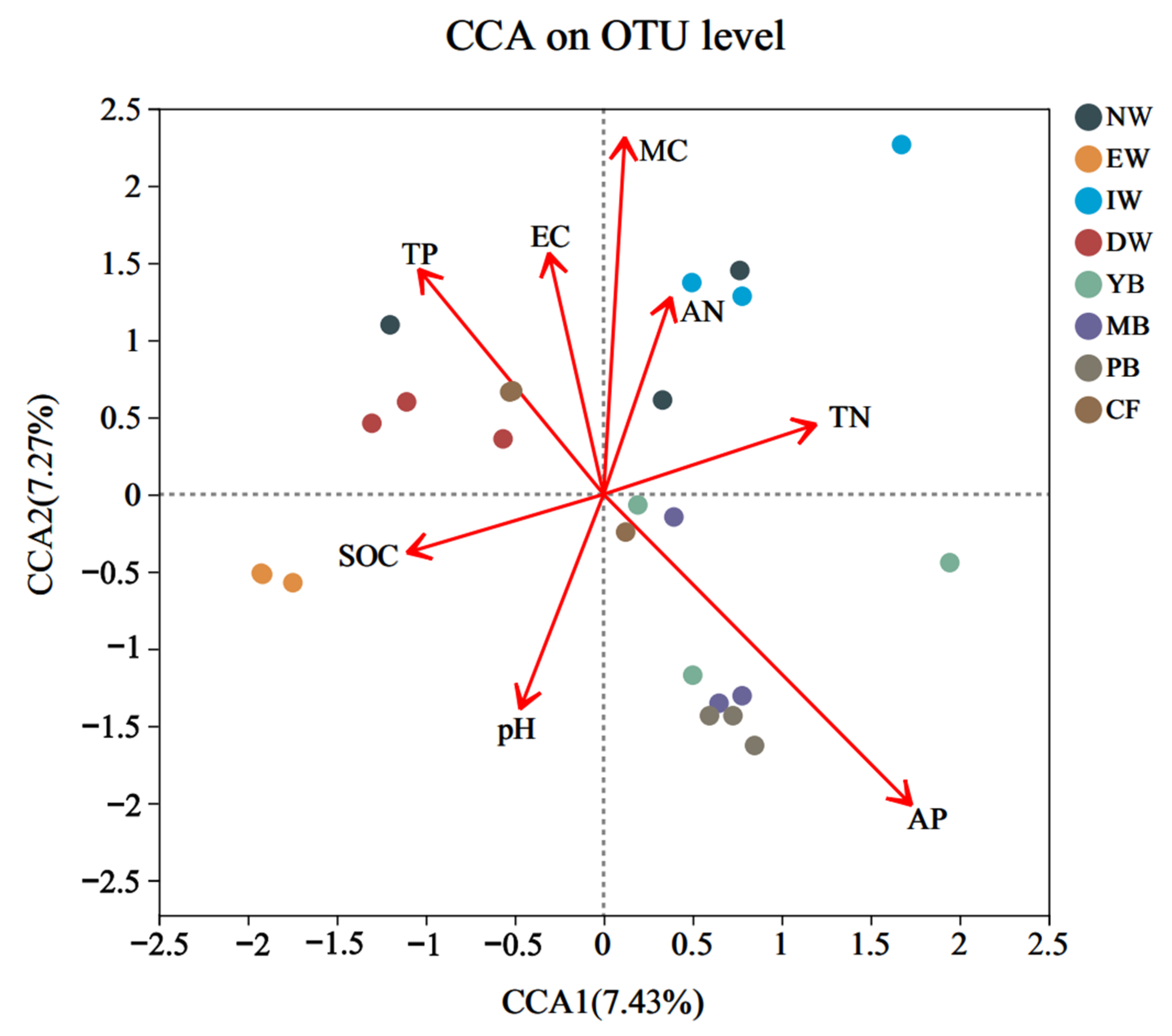
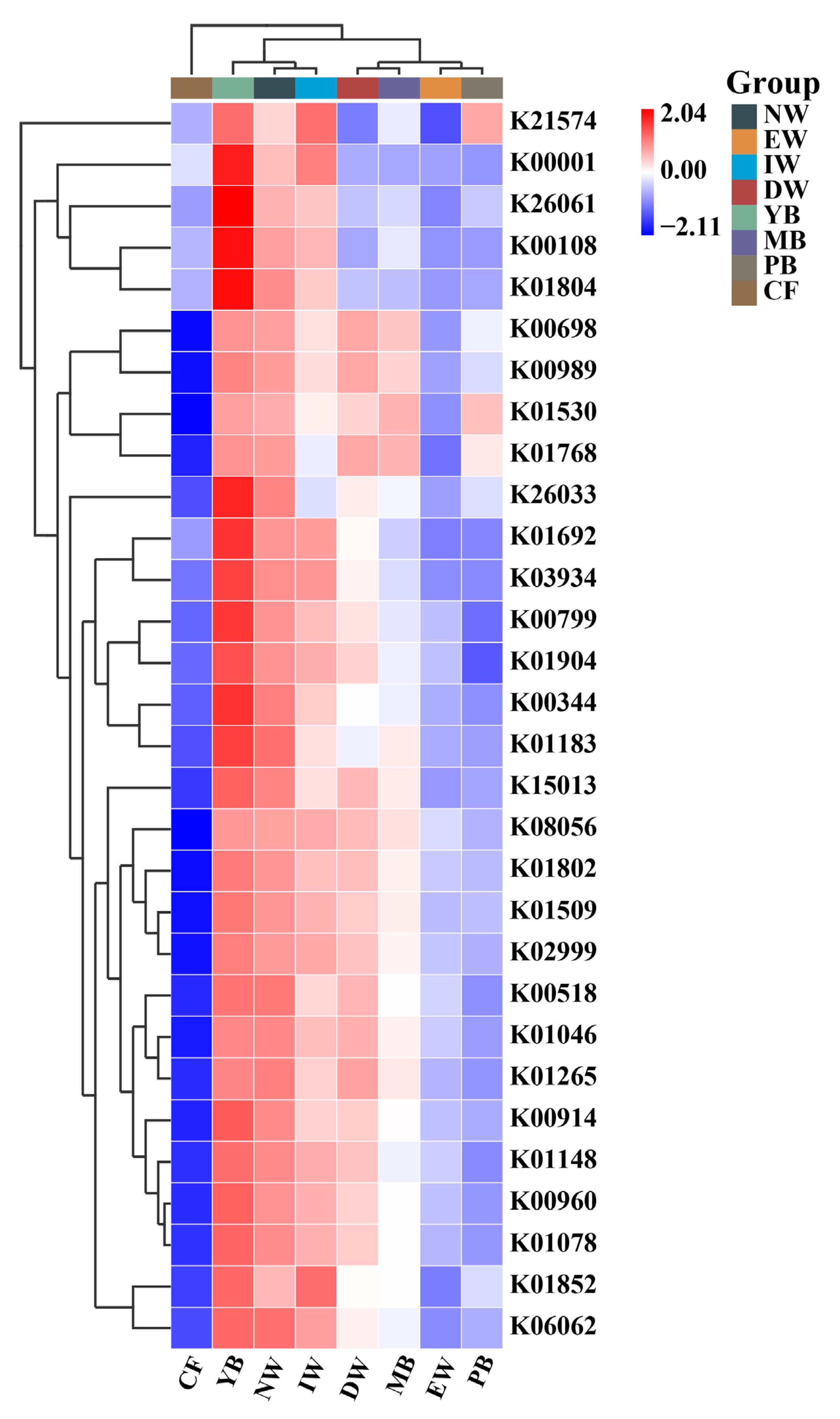

Disclaimer/Publisher’s Note: The statements, opinions and data contained in all publications are solely those of the individual author(s) and contributor(s) and not of MDPI and/or the editor(s). MDPI and/or the editor(s) disclaim responsibility for any injury to people or property resulting from any ideas, methods, instructions or products referred to in the content. |
© 2024 by the authors. Licensee MDPI, Basel, Switzerland. This article is an open access article distributed under the terms and conditions of the Creative Commons Attribution (CC BY) license (https://creativecommons.org/licenses/by/4.0/).
Share and Cite
Wang, M.; Zheng, C.; Li, M.; Pu, W.; Zhang, R.; Liu, Y.; Sui, X. Variations in Arbuscular Mycorrhizal Fungi Communities During Wetland and Forest Succession in Northeast China. Forests 2025, 16, 45. https://doi.org/10.3390/f16010045
Wang M, Zheng C, Li M, Pu W, Zhang R, Liu Y, Sui X. Variations in Arbuscular Mycorrhizal Fungi Communities During Wetland and Forest Succession in Northeast China. Forests. 2025; 16(1):45. https://doi.org/10.3390/f16010045
Chicago/Turabian StyleWang, Mingyu, Chunying Zheng, Mengsha Li, Wenmiao Pu, Rongtao Zhang, Yingnan Liu, and Xin Sui. 2025. "Variations in Arbuscular Mycorrhizal Fungi Communities During Wetland and Forest Succession in Northeast China" Forests 16, no. 1: 45. https://doi.org/10.3390/f16010045
APA StyleWang, M., Zheng, C., Li, M., Pu, W., Zhang, R., Liu, Y., & Sui, X. (2025). Variations in Arbuscular Mycorrhizal Fungi Communities During Wetland and Forest Succession in Northeast China. Forests, 16(1), 45. https://doi.org/10.3390/f16010045






